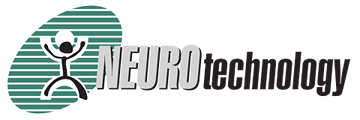Press Release
New MegaMatcher 4.0 from Neurotechnology Integrates Fingerprint, Iris, Facial and Palmprint Biometrics In One High-performance SDK
MegaMatcher SDK Now Incorporates the Latest Versions of VeriFinger, VeriEye, VeriLook SDKs and Palmprint Identification, Built With a Common Architecture and Programming Interface for Faster, Easier Development of Multibiometric Solutions
Vilnius, Lithuania – January 10, 2011 – Neurotechnology, a provider of high-precision biometric identification technologies, today announced the release of MegaMatcher 4.0, a multi-biometric software development kit (SDK) that integrates fingerprint, iris, facial and palmprint biometrics in a single, high-performance SDK that requires no add-ons. In MegaMatcher 4.0, Neurotechnology has incorporated palmprint technology along with the latest versions of their popular VeriFinger (fingerprint), VeriEye (iris) and VeriLook (facial) biometric SDKs – all of which are now built on a common architecture and feature a common programming interface. This tight integration enables developers and integrators to more quickly and easily develop systems that use any of the different biometric components singularly or in combination for increased flexibility and reliability.
"In the last few years, we have been approached by customers requesting that we unify our API for different platforms as well as different biometric modalities," said Pavel Cuchriajev, software development team lead for Neurotechnology. "Now our customers will have a consistent programming model across all biometric modalities, starting with image capture from a biometric device and ending with examination of matching results across all platforms and programming languages," Cuchriajev added.
The new product line of VeriFinger, VeriEye and VeriLook SDKs, which are available separately as well as being components of MegaMatcher, offer a number of enhancements over previous versions. Among the significant changes is the new complete MegaMatcher SDK API for Java, which allows tighter integration with common Java development environments and provides the same full support of MegaMatcher SDK functionality as for the .NET Framework and C/C++. The new device management component provides the same cross-platform API on Windows, Mac and Linux platforms and is consistent for C/C++, .NET Framework and Java programming languages for all supported devices: single flat, rolled and multi-finger scanners, palmprint scanners, iris scanners and cameras. Neurotechnology worked side by side with device vendors to integrate both new and old devices with this new component, ensuring outstanding stability and integration. Other changes in MegaMatcher SDK include improved WSQ support.
In addition to the cross-product additions, the new individual biometric SDKs include enhancements to reliability and performance. The new VeriEye 2.3 algorithm provides a 70% increase in iris matching speed while keeping the same high level of reliability as the previous version. The VeriLook 5.0 facial identification algorithm offers even higher reliability than version 4.0, with a 20% to 50% decrease in the False Rejection Rate comparatively. VeriFinger 6.3 increases reliability with a new fingerprint segmentation component that provides a 20x decrease in the segmentation error rate with a simultaneous 10x increase in segmentation speed.
Neurotechnology first released MegaMatcher as an automated fingerprint identification system (AFIS) in 2005, then added a facial recognition engine in version 2.0, with a fusion algorithm that allowed the two technologies to work together to provide very fast 1:N (1 to many) matching with even higher reliability than AFIS or facial recognition alone. In subsequent versions, enhancements to MegaMatcher included add-ons for iris and palmprint identification. Now, with MegaMatcher 4.0, all four biometric technologies are incorporated natively, with very fast, highly accurate algorithms that are designed to work together in any combination.
Large-scale government and commercial solutions worldwide depend on MegaMatcher technology as the biometric engine for high-volume, high security applications, including: election control, passport and visa documentation, border control, criminal investigations and duplicate searches in large-scale databases. MegaMatcher supports most biometric industry standards, and because the MegaMatcher fingerprint recognition algorithm is NIST MINEX-compliant, it is suitable for use in US Government Personal Identity Verification program fingerprint recognition applications.
MegaMatcher 4.0 is available through Neurotechnology or from distributors worldwide. For more information, go to: www.neurotechnology.com.
About Neurotechnology
Neurotechnology is a provider of high-precision biometric fingerprint, face, iris and palmprint identification algorithms, object recognition technology and software development products. More than 2000 system integrators, security companies and hardware providers integrate Neurotechnology's algorithms into their products, with millions of customer installations worldwide.
Neurotechnology's identification algorithms have consistently earned the highest honors in some of the industry's most rigorous competitions, including the National Institute of Standards and Technology (NIST)'s Fingerprint Vendor Technology Evaluation (FpVTE) and IREX and the Fingerprint Verification Competitions (FVC).
Drawing from years of academic research in the fields of neuroinformatics, image processing and pattern recognition, Neurotechnology was founded in 1990 in Vilnius, Lithuania and released its first fingerprint identification system in 1991. Since that time the company has released more than 60 products and version upgrades for identification and verification of objects and personal identity.
Media Contact
Jennifer Allen Newton
Bluehouse Consulting Group, Inc.
+1-503-805-7540
jennifer (at) bluehousecg (dot) com
